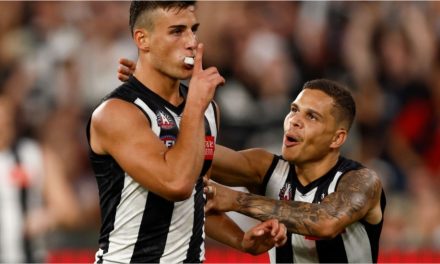Dejected Sydney players leave the MCG after their inaccurate loss to Collingwood last Sunday. Photo: AFL MEDIA
From a coaching and playing perspective, AFL football has never been a more technical game than it is now.
Coaching panels can spend weeks putting together a particular plan of attack for a specific opponent and spend inordinate training and meeting time drilling it into their players so that it becomes habitual.
And Sydney, up against top team Collingwood on Sunday, appeared to have come up with a good one. The Swans concentrated on owning the football themselves at the Magpies’ expense, chipping it around the Pies’ defensive structures.
For much of the game, Sydney had possession. It finished with 78 more disposals than Collingwood, and 99 more uncontested possessions, a statistic in which the Pies ranked third going into the game, and the Swans only 13th. The Swans had a whopping 132 marks, and fashioned 18 scores.
The plan was carried out well, with just one problem. And it was a big one. It was that when it came to the most important part of the deal, the “money shot” as it were, the Swans couldn’t hit the side of a barn, a wildly inaccurate 6.12 (48) costing them any chance of victory.
A little earlier, across the state border, Port Adelaide had emerged from a considerable early slumber to completely turnaround its home game against Essendon.
After conceding a 21-point lead, the Power got on top in just about all areas, winning the contested ball well and ending up with 18 more forward entries after having only broken even at quarter-time, scoring with every second inside 50.
Problem? Again, a large one. It was scoring behinds, not goals, 20 of them in fact, while about the one thing Essendon has going for it come the second half, was accuracy.
The Power wasted a dominant second term with 2.7, and come the final change, led by just one point despite having had 25 scores to just 14. That Port clung on for a five-point win would have been a massive relief for coach Ken Hinkley. And not for the first time.
Four of Port’s past five games now have been decided by 14 points or less. But the Power have made hard work of all of them, last week’s 12.11 (83) against St Kilda the most accurate (or least inaccurate) of all those winning scorelines.
Hinkley knows his team is flirting with danger, pointing out after the Essendon win that more than 40 per cent of 72 AFL premiership season games now have been won by three goals or less. No wonder poor conversion is standing out even more dramatically.
Eight of 18 sides over the weekend kicked as many or more behinds than goals. North Melbourne and St Kilda (unusually for the Saints this season) in pristine conditions under a roof combined for a very wobbly 12.26.
PLEASE HELP US CONTINUE TO THRIVE BY BECOMING AN OFFICIAL FOOTYOLOGY PATRON. JUST CLICK THIS LINK.
Now take a look at the AFL ladder after eight rounds. Four of the top six teams – Melbourne, Geelong, Brisbane and St Kilda – are among the current five most accurate sides in the competition.
The other one of those five teams, Essendon, remained a winning chance against Port Adelaide on Sunday right until the final siren really only because of that accuracy and its opponent’s inaccuracy. And the bottom three sides – North Melbourne, West Coast and Hawthorn? Yep, they’re officially the three most inaccurate sides going around. Do clubs need any more convincing that bad kicking is bad football?
And yet the curse continues. Goalkicking accuracy is clearly more critical than ever, yet it remains the one skill in the game which doesn’t improve. And Champion Data’s Christian Joly produced some interesting statistics for ESPN’s “Footy Podcast” a few weeks back which confirmed this isn’t just anecdotal observation.
Accuracy rates have barely budged at all since reaching an all-time low in 2019, when, even from the corridor, conversion was going at just 51.8 per cent, that is, just over one of every two shots taken even from directly in front of goal. Consider that in 2010, the equivalent figure was 62.8 per cent.
That’s some sort of drop off. And it applies almost equally to set shots as well, accuracy rates having fallen from 60.2 per cent in 2010 to less than 54 per cent today.
There’s been plenty of theories pushed as to why. More fatigued forwards, more shots taken from less favourable positions. One which I think does have some credence is that more players are getting on the scoresheet each week than previously, when goalkicking responsibilities were entrusted to a relative handful (in comparison) of specialists.
Whatever the reasons, though, it remains a puzzle that more time and resources still don’t appear to be devoted to the art of goalkicking. We still hear players grumble about being denied enough practice time, whether via paranoid fitness men or sceptical coaches.
But if that figure of 40 per cent of games being decided by three goals or less holds for the remainder of the season, that’s conceivably at least nine games for each team the results of which could be reversed by more accurate or inaccurate kicking at goal.
Port Adelaide can’t continue to count on sheer volume of scoring opportunities getting it over the line. Sydney? Well, the Swans lost a game to Port Adelaide by a solitary point after kicking 9.10, and again last week to GWS after their opponent booted a deadly accurate 17.5.
That is the very definition of a twist on that old maxim, the Giants underscoring that good kicking is indeed good football. But more pointedly than that, in 2023 good kicking could well also be the difference between playing finals or not.
This article first appeared at ESPN.











